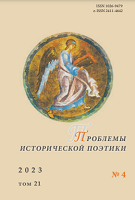Художественное осмысление соборности в прозе русского зарубежья (И. С. Шмелёв, И. А. Бунин, Б. К. Зайцев, Л. Ф. Зуров, В. А. Никифоров-Волгин)
Artistic Understanding of the Category of Conciliarity in the Prose of Russian Abroad About the Age of Social Cataclysms in the Beginning of the 20th Century (I. S. Shmelyov, I. A. Bunin, B. K. Zaitsev, L. F. Zurov, V. A. Nikiforov-Volgin)
Author(s): Victoria Zakharova, Irina S. KudryavtsevaSubject(s): Russian Literature, Theory of Literature, Identity of Collectives, Sociology of Literature
Published by: Петрозаводский государственный университет
Keywords: conciliarity category; Russian Diaspora; I. S. Shmelev; I. A. Bunin; B. K. Zaitsev; L. F. Zurov; V. A. Nikiforov-Volgin; poetics; artistic consciousness;
Summary/Abstract: The category of conciliarity is one of the most important in the Russian national identity. The purpose of this article is to study the originality of artistic understanding of the category of conciliarity in the works of I. A. Bunin, I. S. Shmelev, B. K. Zaitsev, L. F. Zurov, V. A. Nikiforov-Volgin, dedicated to the events of pre-revolutionary and post-revolutionary years in Russia, when the thousand-year-old foundations of national spiritual identity were rapidly and dramatically destroyed. The analysis made it possible to discover a wide variety of distinctive individual features in the poetics of each artist’s works that allow to introduce these texts into the “big time” chronotope. The artistic consciousness of I. S. Shmelev is characterized by an explicit expression of feelings and emotional states of the characters; plot situations in which the direct actions and statements of the characters reveal the essence of the phenomena being comprehended are significant. In I. A. Bunin’s and B. K. Zaitsev’s works, plot circumstances often have a subtextual, associative, symbolic meaning, expressing a sense of personal involvement in ancient spiritual traditions. It was not for nothing that L. F. Zurov was considered a student of I. A. Bunin: his poetics has similar features. However, at the same time, the author’s “open” intonations are inherent in it. In V. A. Nikiforov-Volgin, the originality of artistic thinking in comprehending the problem of the existence of the conciliarity tradition in Russian life, despite the most severe vicissitudes, is often articulated in expressively colored dramatic plot situations. However, the leitmotiv basis of his texts makes itself felt along with the parable manner of understanding reality. Thus, using the works of famous writers of the first-wave Russian emigration as examples, the “living life” of the natural conciliar self-awareness of the Russian people is revealed, helping them to preserve their faith and survive despite difficult trials.
Journal: Проблемы исторической поэтики
- Issue Year: 21/2023
- Issue No: 4
- Page Range: 386-411
- Page Count: 26
- Language: Russian

